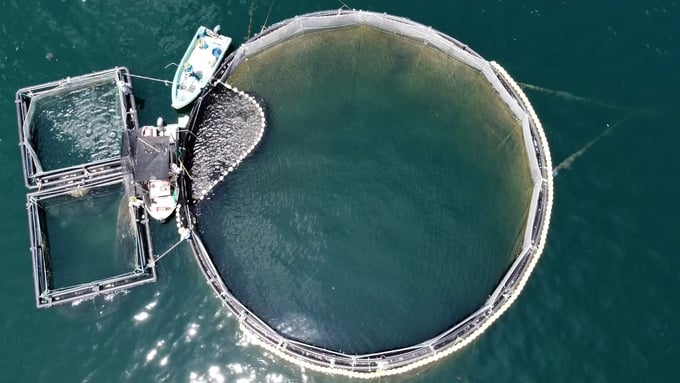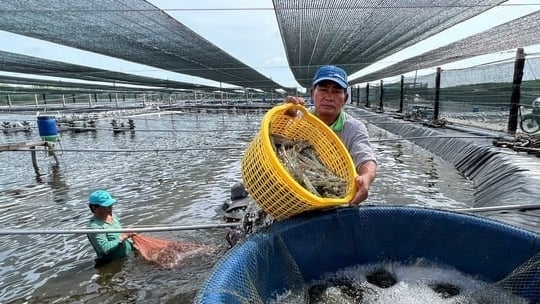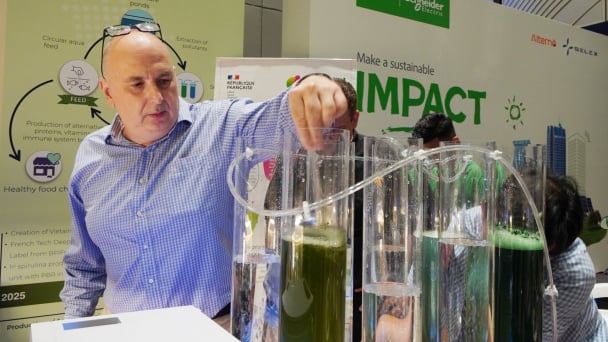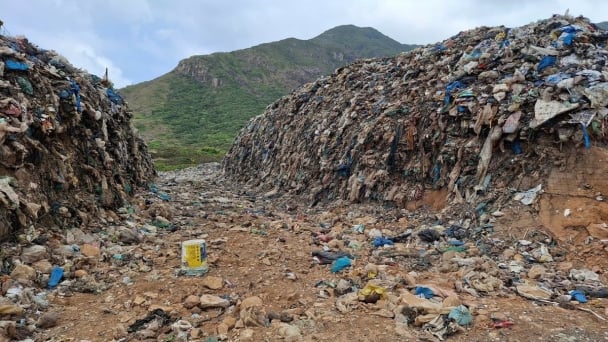May 30, 2025 | 03:04 GMT +7
May 30, 2025 | 03:04 GMT +7
Hotline: 0913.378.918
May 30, 2025 | 03:04 GMT +7
Hotline: 0913.378.918
The Norwegian Embassy in Vietnam and the Directorate of Fisheries (under the Ministry of Agriculture and Rural Development) co-chaired a meeting titled "Sharing Experiences in Developing a National Brand for Vietnamese Mariculture" on the afternoon of June 5 in Hanoi city.
At the meeting, Director of the Directorate of Fisheries Tran Dinh Luan noted that Norway began by successfully organizing the mariculture industry in order to build a brand for its salmon product. Namely, Norway's mariculture evolved from a small-scale operation into a branded, industrial-scale industry that fulfills the most demanding requirements in various international markets.

Mette Møglestue, Deputy Head of Mission at the Norwegian Embassy and Tran Dinh Luan, General Director of the Directorate of Fisheries co-chaired the meeting. Photo: Hong Tham.
Additionally, Norway has a long history of cooperation and sharing valuable expertise with Vietnam. Notably, Norway is a driving force behind the development of Vietnam's mariculture industry.
"We hope that Norway will continue to support Vietnam's fisheries sector in establishing standards, regulations, and technical economic norms, which will serve as a foundation for the development of mariculture in Vietnam. We aim to use these standards and regulations to facilitate the participation of other economic components, such as insurance, lending, and other economic activities that can support Vietnam's mariculture," emphasized General Director Luan.
Mette Møglestue, Deputy Head of Mission at the Norwegian Embassy, stated that Norway is a world leader in the fisheries exploitation and aquaculture industry, with core values centered on sustainable development and environmental protection.
"We highly value Vietnam's goals in the fisheries sector, which include reducing fishing intensity and enhancing mariculture in suitable areas as outlined in the Vietnam Fisheries Development Strategy until 2030, with a vision towards 2045. In our opinion, Vietnam has been favorably positioned to engage in global value chains, harness its oceanic potential, and utilize ocean resources responsibly and sustainably," noted Deputy Head of Mission Mette Møglestue.
Additionally, she remarked, "As the world's leading seafood exporters, Norway and Vietnam both understand the importance of a strong national brand, along with other factors such as quality, nutritional value, and sustainable farming and fishing practices, in enhancing the export value of seafood products. We are delighted that representatives from the Norwegian Seafood Council (NSC) have the opportunity to share the stories of Norwegian salmon and the Seafood from Norway brand at today's meeting."
"I hope this information will be beneficial to Vietnam. Norway is always ready to share its knowledge and experience as Vietnam builds a strong national brand for mariculture and seafood exports," emphasized Deputy Head of Mission Mette Møglestue.
Ngo The Anh, Head of the Aquaculture Department at the Directorate of Fisheries, stated that Vietnam's brand development direction for mariculture involves establishing brand and product quality standards; protecting intellectual property rights both domestically and internationally; promoting the brand; and protecting and developing the brand.
Subsequently, Ngo The Anh proposed several tasks for Vietnam in the near future, including: promoting the shift from single-value to multi-value economics in the production mindset; restructuring the mariculture sector; enhancing cooperative linkages and creating mariculture value chains; prioritizing production in compliance with market requirements; and establishing brands for marine-based product lines.

Asbjørn Warvik Rørtveit, Director of South-East Asia at the Norwegian Seafood Council (NSC), shared that Norway is currently the world's largest seafood exporter. Photo: Hong Tham.
According to Asbjørn Warvik Rørtveit, Director of South-East Asia at the Norwegian Seafood Council, the Norwegian seafood industry is relatively young at just 50 years old. The industry has produced various species of fish and supplied over 20 million people worldwide since its establishment.
Norway is the world's largest seafood exporter, with a value of 172 billion NOK and an export volume of 2.8 million tons. Norwegian seafood has established its presence across 153 markets worldwide. Notably, Norwegian salmon is the country's key seafood export, accounting for over 71.3% of its total export volume. Other key exports include cod, chub mackerel, herring, black cod, among others. The highlight of Norwegian seafood is its focus on traceable products.
During the meeting, Director Asbjørn Warvik Rørtveit revealed several "secrets" to Norway's success in the seafood industry, such as appointing famous Norwegian footballer Erling Haaland as the global ambassador for Norwegian seafood, or setting goals to increase the value of Norwegian seafood by increasing demand and knowledge regarding Norwegian seafood in the market.

Norway highly values Vietnam's objectives in the fisheries sector, which include reducing fishing intensity and enhancing mariculture in suitable marine areas. Photo: Hong Tham.
Director Asbjørn Warvik Rørtveit also posed the question: "Why do consumers choose Norwegian seafood?" To which he suggested that the answer lies in "the story of Norwegian seafood, its origins, and its sustainability. When consumers understand these aspects, they will gain a better understanding of the Norwegian seafood value. The role of media is crucial."
"We need to focus on the community and sustainability. How can we maintain sustainability for over a thousand years? The key here is not just sharing a story, but the story must also be true. Consistency must be the priority in our stories," emphasized Director Asbjørn Warvik Rørtveit.
Director Asbjørn Warvik Rørtveit added that the key to brand building is marketing, which is the final step in the value chain. However, it is essential to understand the value chain as a whole, and the story we want to share as producers.
He underscored the "3 core communication elements" that NSC employs to promote the image of Norwegian seafood to consumers: nature, human, and sustainable development.
General Director Tran Dinh Luan concluded: "We hope to receive further support from the Norwegian Embassy and the Norwegian Seafood Council in developing Vietnam's mariculture industry, and harnessing the economic potential of the sea; thereby improving the livelihoods of coastal residents. This is also an opportunity to reduce coastal exploitation, enhance the protection and conservation of fisheries resources, and preserve our marine environment."
Translated by Nguyen Hai Long

(VAN) Ms. Nguyen Thi Dung, Deputy Director of Ngoc Hoang Cooperative, shared about the journey of bringing dragon fruit to Europe, achieving annual revenues in the billions of VND.

(VAN) Bamboo products from Thang Tho Bamboo Cooperative have reached many countries around the world, while also creating jobs for local workers.

(VAN) The Management Board of Con Dao National Park reported that a green sea turtle, tagged in the Philippines, has traveled thousands of kilometers to lay 84 eggs on Bay Canh Islet.

(VAN) Green technology is paving a new path for sustainable aquaculture in the Mekong Delta in particular and across the country in general, helping reduce emissions and adapt to climate change.

(VAN) On May 27, La French Tech Vietnam (the French startup and innovation community in Vietnam) held the French Tech Summit Vietnam 2025.
/2025/05/27/4731-2-223159_980.jpg)
(VAN) No votive paper, no styrofoam, no plastic bags, no plastic bottles, and no single-use plastic trays are the key rules tourists should keep in mind when visiting Con Dao.

(VAN) In the fight against plastic pollution, Vietnam has been demonstrating a proactive, pioneering, and active role in addressing the greatest environmental challenge today.